Your donation will support the student journalists of The Tide, Richard Montgomery High School's student newspaper. Your contribution will allow us to purchase equipment and cover our annual website hosting costs.
Disney has held a strong hold over the film industry for decades.
A (school) year of movies: RM reviews eight movies
May 17, 2023
A school year finished means homework assignments finished, exams finished, classes finished—and movies finished. Read what RM students thought of all the movies they watched this year.
- Released March 25, 2022: Everything Everywhere All at Once, reviewed by Emil Fang
- Released Sept. 16, 2022: Do Revenge, reviewed by Liliana Katz-Hollander
- Released Sept. 23, 2022: Don’t Worry Darling, reviewed by Naomi Scissors
- Released Nov. 11, 2022: Wakanda Forever, reviewed by Adi Bala
- Released Nov. 15, 2022: Strange World, reviewed by Naomi Scissors
- Released Dec. 16, 2022: Avatar: The Way of Water, reviewed by Claire Xu
- Released Feb. 17, 2023: Ant-Man and the Wasp: Quantumania, reviewed by Adi Bala
- Released Feb. 24, 2023: Cocaine Bear, reviewed by Naomi Scissors
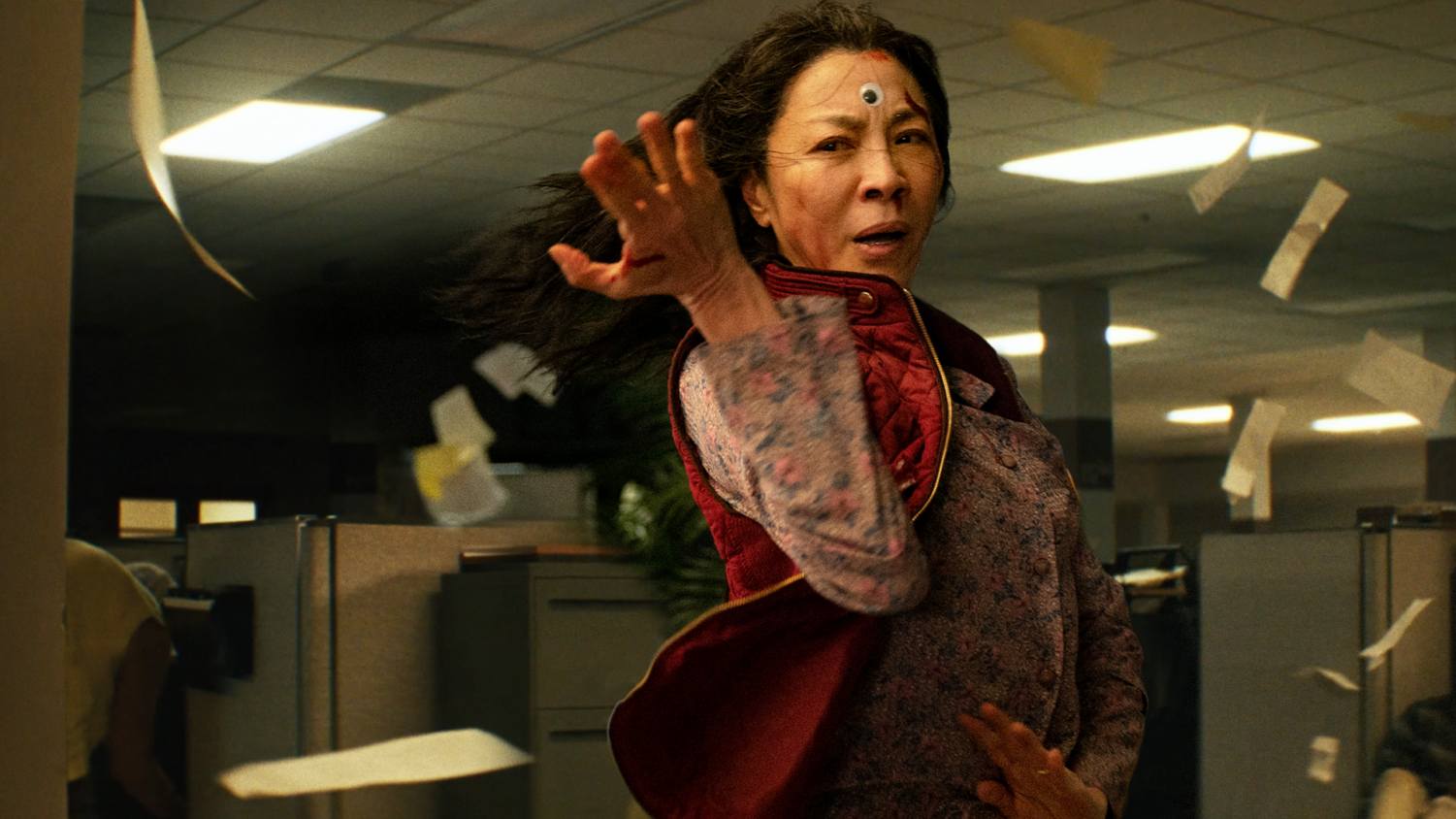
Michelle Yeoh plays Evelyn Wang, a Chinese laundromat owner-turned-superhero who is thrust into the multiverse.
‘Everything Everywhere All at Once’ lives up to its 11 Oscar nominations
The film Everything Everywhere All at Once mixes comedy and drama and was both written and directed by the award-winning brothers Daniel Kwan and Daniel Scheinert. The cast includes Michelle Yeoh as the main character, Evelyn Wang, Ke Huy Quan as Waymond Wang, Evelyn’s husband, and Stephaine Hsu as their daughter, Joy. The plot follows Evelyn’s journey through different dimensions, being audited by the IRS, and generational trauma. The movie had a relatively low movie budget of 14 million dollars and grossed over 103 million dollars, becoming A24’s highest grossing film to date. The movie features incredible writing and stunning handmade visuals created by a team of just five talented artists.
“Wow” was the first thing I thought when I finished this film. Its small budget does not take away from its impact at all. The movie does not spare any creativity with its costumes; each outfit is immaculately crafted even if it is shown for a couple of seconds. From a pro wrestling costume to an Elvis jacket to high fashion, multiple styles appear in scenes that last a couple seconds. The visuals do not fall far behind either, as the apartment the Wang family lives in is cluttered with items, some worn with age and use. It feels like a realistic family home. These simple visuals are followed by fast paced visuals of Evelyn jumping through multiverses, each second containing Evelyn with a different appearance and in a different world, or the screen shattering with two different Evelyns in between the cracks. The action scenes are just as engaging, coordinated by martial artists Andy and Brian Le. The fight scenes seamlessly mix comedy with action.
Complementing the visuals is an exceptionally written story. The family feels realistic, and the dialogue between characters is natural. The way Evelyn talks to Joy and the multiverse versions of Joy made me feel like it was my own mother talking on the screen, Evelyn’s mannerisms also reflect my mothers, especially the way Evelyn switches from Mandarin Chinese to accented English.The comedic moments genuinely made me laugh with how well written they are even if they are sometimes a little crude. And while the movie does have Evelyn jumping through dimensions and experiencing different lives, the core of the movie is a compelling family drama. The multiverse is used to develop Evelyn’s character throughout the story. The multiversal setting allowed the Daniels to be creative about Evelyn’s development as a character and allowed them to play with some new possibilities.
However, the story would be nothing without the actors who play their characters perfectly. The acting never falls flat throughout the film. Michelle Yeoh’s acting is top notch as Evelyn—through Yeoh, Evelyn is brought to life. She feels like a real person who has had real disappointments and regrets throughout her life. Ke Huy Quan, despite not acting since the late ’90s, excels at his role as a soft-hearted and goofy husband and father. Stephanie Hsu plays the slightly estranged daughter role flawlessly, as a daughter who feels unappreciated by her mother. Due to the multiversal setting, the actors sometimes have to completely switch the personalities of their characters from calm to aggressive or sane to insane and each change is smooth, with no hesitation.
Everything Everywhere All at Once is a must-watch film. While not perfect, it comes close to perfection with a team that was clearly passionate about the movie they were making. It is almost criminal that this movie is not talked about and appreciated more.
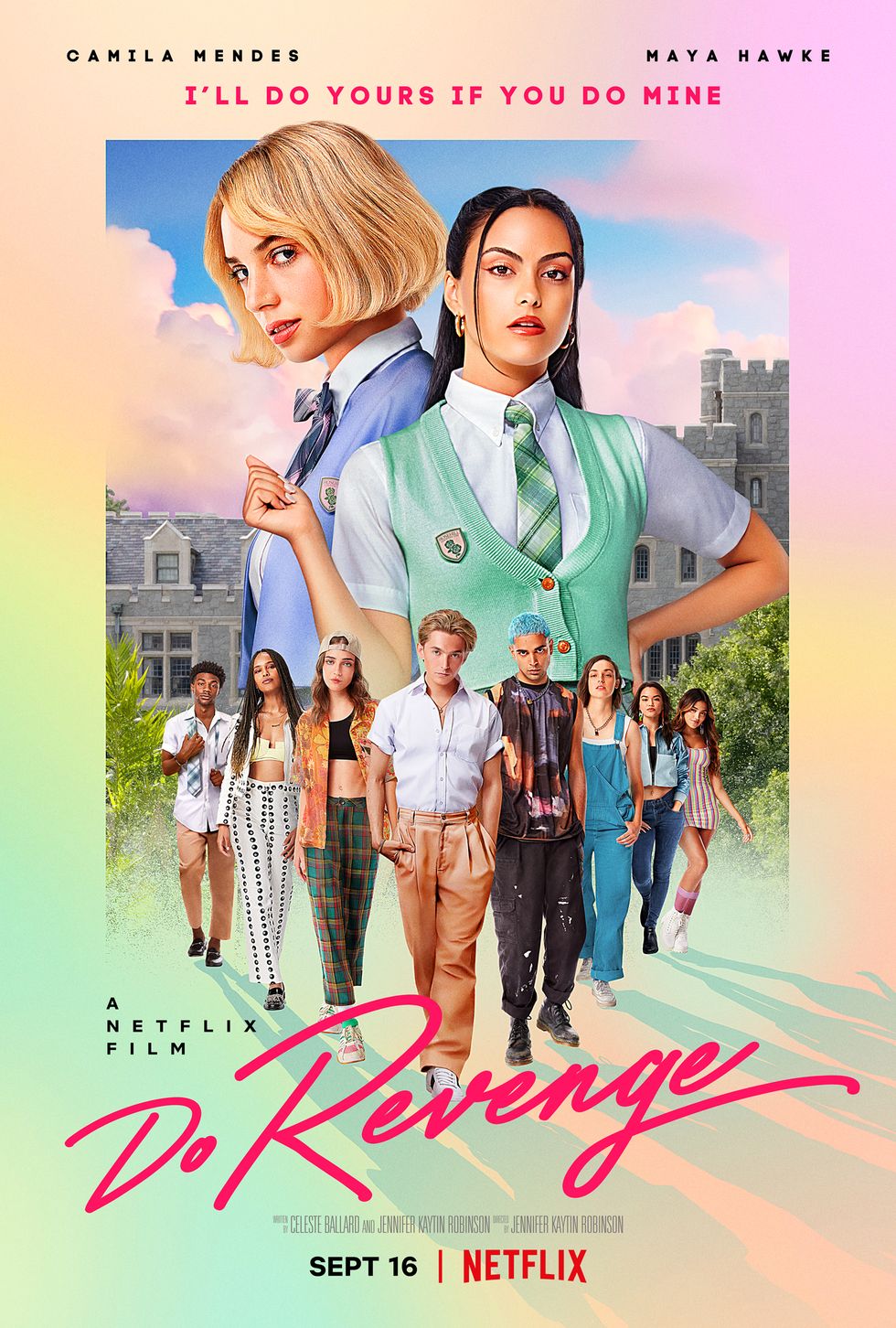
In ‘Do Revenge,’ the protagonist Drea tries to take revenge on her boyfriend for publishing a sex tape.
‘Do Revenge’ could be the chick flick that defines Gen Z
Many of Netflix’s recent original teen movies, such as “Tall Girl,” “The Kissing Booth” and “He’s All That” have been criticized and denounced as trashy or cliched. However, the new Netflix original, “Do Revenge”, starring Camila Mendes and Maya Hawke, might be the movie that has succeeded where the others have failed, and be the movie that defines Gen Z.
In every decade, there is at least one movie that is looked upon as the teen movie–one that represents the style, music, culture, and views of that generation. And more often than not, they’re “chick flicks.” This ranges from “Sixteen Candles” in the ‘80s, to “Clueless” in the 90s, to “Mean Girls” in the 2000s.
“Do Revenge” is a new spin on this type of movie. Although it takes place in a California high school, as all the classics do, and centers on teenage relationships and drama, the plot itself is very unique. Drea, played by Camila Mendes, is an ambitious high school senior from a poor background, who has secured not just a spot in one of the most elite private high schools in the county, but also connections, opportunities, and privileges, finds her life upturned when her boyfriend humiliates her in front of the entire school. She ends up teaming up with Eleanor, played by Maya Hawke, who is haunted by a rumor from her past, to get revenge on those who have wronged them–by doing the other’s revenge.
The cast of this movie is one of the first indicators that it would be a hit with Gen Z. The two lead roles, Drea Torres and Eleanor Levetan, are played by Camila Mendes and Maya Hawke, respectively. Camila Mendes has appeared in Netflix original movies before, but she is best known for her lead role as Veronica Lodge in “Riverdale,” the original Netflix series which is one of the most streamed in the world. Maya Hawke has also primarily acted in Netflix original movies in the past, but Hawke, the daughter of Uma Thurman and Ethan Hawke, achieved fame in her role as Robin in “Stranger Things”, the second most viewed Netflix show in the world. In short, Mendes and Hawke alone are enough to draw millions of viewers. However, the supporting cast also includes stars like Sophie Turner, famous actress, Paris Berelc, who played Alexa in the hit Netflix series “Alexa and Katie”, and Sarah Michelle Gellar, known for her role as Buffy in “Buffy and the Vampire Slayer” and Daphne in “Scooby Doo.”
Including Gellar, who was one of the most recognizable actresses of the early 2000s, is one of many homages, both subtle and overt, that “Do Revenge” pays to the teenage classics of that era. At times the characters even come close to breaking the fourth wall. When Eleanor is offered a tour of the school by her future love interest, Gabbi Broussard, played by Talia Ryder, she says “as a disciple of the 90s teen movie, I would be offended if I didn’t get one.” There are also more specific instances. In a direct reference to the iconic 2004 “Mean Girls”, Tara, a new take on the classic mean girl, played by Alisha Boe, asks Eleanor “why don’t I know you?”, paralleling the first interaction between Regina George and Cady Heron. There are many other moments that other “disciples of the 90s teen movie” would recognize as references to movies ranging from “The Princess Diaries” to “10 Things I Hate About You”, and more. “Do Revenge” even includes a cover of “Kids in America,” covered by rising pop singer Maude Latour, but originally written by Kim Wilde in 1981. “Kids in America” was covered by The Muffs in 1995 and used as the opening song in “Clueless”.
The soundtrack of “Do Revenge” is another piece of the film’s accurate teen representation. It is a mix of newer hits, older songs, and more obscure pieces. Among its more notable inclusions are Oliva Rodrigo’s smash hit “Brutal,” as well as an orchestrated version of “How Bizarre,” a song from 1996 by OMC that went viral on Tik-Tok in 2021. The soundtrack also features several prominent queer artists, such as Phoebe Bridgers, MUNA, and Hayley Kiyoko.
And although “Do Revenge”’s pop culture references, fashion, and music are noteworthy, what really makes it stand out as a movie is its social themes. It focuses on classism, homophobia, misogyny, and more. For example, Eleanor is queer, and although her relationships and identity are part of the plot, it is not a conflict, which is something that is not done often enough in current movies. Furthermore, Drea is taken advantage of by her boyfriend and treated as an outcast by her friends. LGBTQ-focused trauma and victim-shaming are major themes in this movie, but it still allows room for teenage ambition and queer joy.
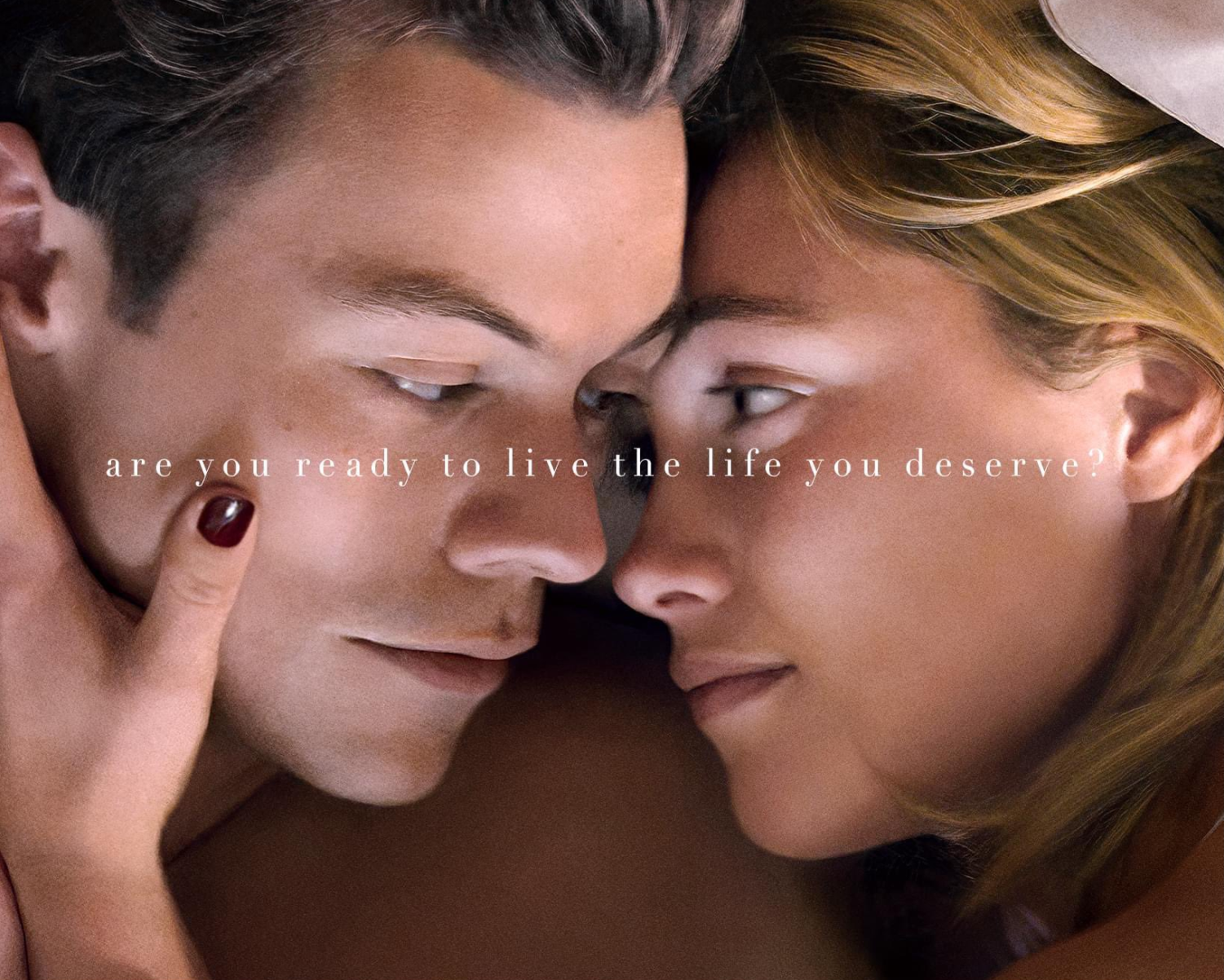
Courtesy of Warner Bros. Pictures
Harry Styles and Florence Pugh star in the film ‘Don’t Worry Darling.’
‘Don’t Worry Darling’ has an underwhelming, lackluster plot
“Don’t Worry Darling” is a visually stunning film, but its beauty is not enough to bolster a lifeless, sometimes nonsensical plot. Director Olivia Wilde, known for her directorial debut Booksmart, shows her skill in well-crafted, shocking moments that deliver on the film’s promise of a thriller, but the storyline itself feels like a rough draft. The production design is stellar, and Florence Pugh delivers a brilliant performance as strong-willed Alice. However, audiences are likely to be left unsatisfied by a plot that falls apart under any form of scrutiny.
The film follows Jack and Alice, played by Harry Styles and Florence Pugh respectively, a young couple living in an idyllic 1950s American town called Victory. The women all stay home and tend to their households, and the men all work for the same company that is ostensibly tasked with something secret and extremely important. But it quickly becomes apparent that things in Victory are not as they seem. Pugh and Styles are believable enough as the young, enamored leads, but it is clear why Styles is renowned for his singing and not his acting, especially when contrasted with Pugh’s nuanced performance. Styles stumbles through the film without ruining the illusion, but at most times he comes across as Harry Styles pretending to be a character rather than the character himself.
Chris Pine and Gemma Chan give strong performances as Frank and Shelley, the man that founded the Victory empire and his wife. They provide the eerie charisma necessary to build a creeping sensation throughout the film, that something is not quite right in this seemingly utopian town. The problem is that this feeling does not go anywhere until the final half hour of the film’s two hour run.
The moments shown in trailers and teasers follow an undoubtedly effective formula. Take a symbol of banal suburban life, such as morning eggs or washing windows, tweak a small element to give it an unsettling feel, and let Pugh’s acting sell the rest. It works, and Pugh performs with the same brilliant subtlety that made “Midsommar” successful, but while these moments may be perfect for an interesting teaser, they cannot form an entire film by themselves. The majority of the film is a plotless mash of interesting visuals and creepy montages, and when the reveal finally comes at the end it fails to justify many of the strange happenings that occur throughout the movie. The result is a film that feels like a stranded first act with no explanations and no second act to offer a resolution for its characters.
The little plot the film does have is nothing new. Audiences are no longer impressed by a suburban utopia with a dark twist, darkness has come to be expected wherever there is aggressive happiness and Americana, so there is nothing interesting about Wilde’s reveal that life in Victory is not as perfect as it seems. Cliche, of course, does not ruin the plot of a film. It is nearly impossible to make a film without copying something that has already been done. However, the film offers very little of its own to the mix. There is nothing distinguishing the film from being a too-long episode of “Black Mirror,” a less scary “The Village,” or a less insightful “Stepford Wives.” It does not improve on a known concept, rather, it packages something entirely unoriginal in a shiny new celebrity-studded package.
“Don’t Worry Darling” is a fun watch, and it may be enough to satisfy Styles superfans, but it does not hold up as the societal critique it attempts to be. The myriad of celebrity drama that surrounds the film is sure to draw some to the theater, but the film’s underwhelming box office performance shows that audiences are still expecting more from a film than gossip and name recognition. Wilde is undoubtedly talented, and perhaps with her second feature film under her belt she will bring the artistry she brought to “Booksmart” to her next project.
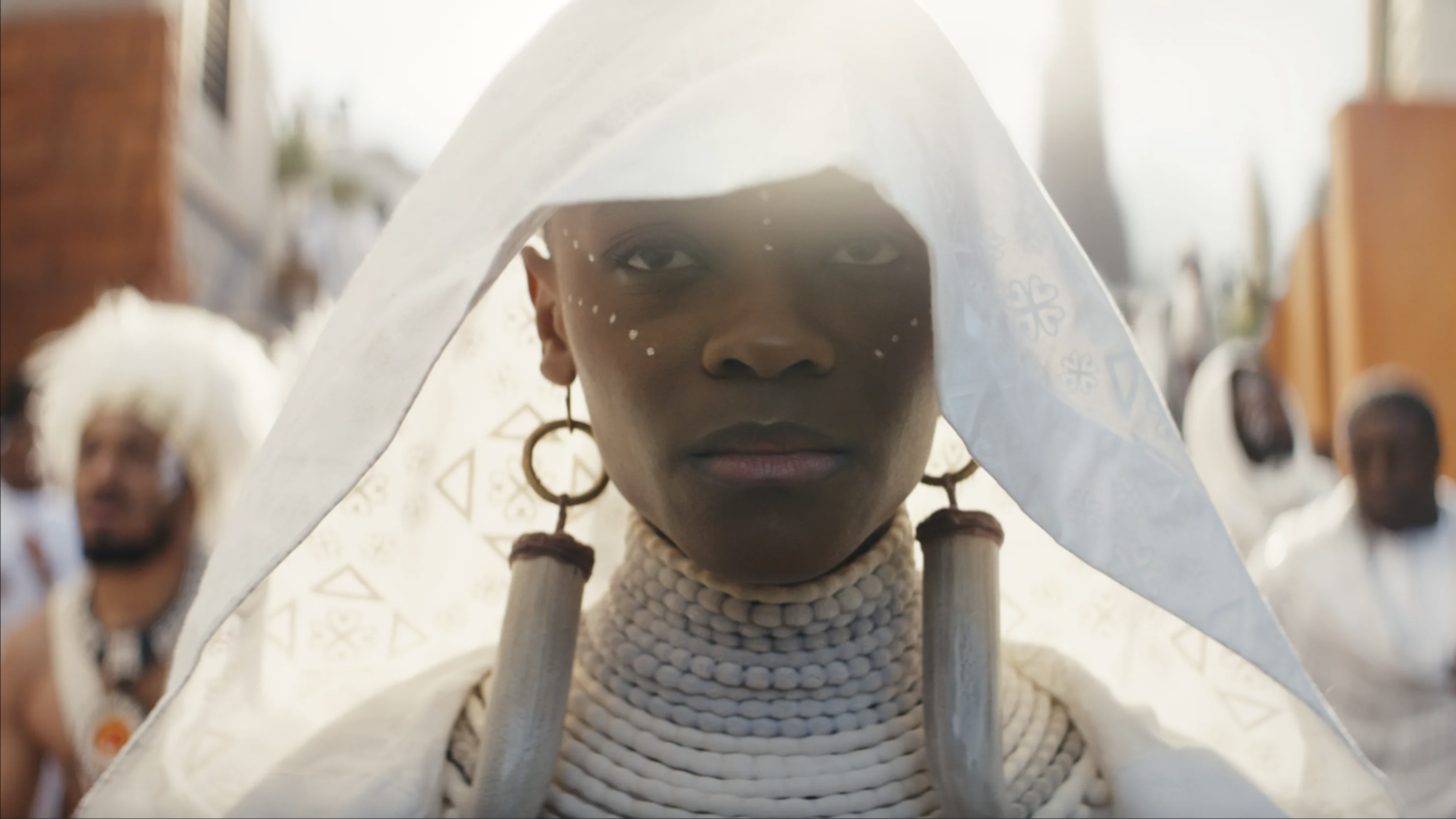
Shuri, the new hero of the Black Panther series, walks in T’Challa’s funeral procession.
How to not live up to standards: ‘Wakanda Forever’
Four years have passed since actor Chadwick Boseman donned a sleek black costume as the iconic namesake of Marvel’s “Black Panther.” During this period, Boseman passed, and the world was shocked by change after change; four years felt like an eternity. Anticipation was at an all-time high for the film’s sequel, “Black Panther: Wakanda Forever,” when it was released on Nov. 11, and while fans flocked to the theaters in record numbers, the production accrued over $180 million in its first week, ending one of the worst box office droughts in history.
While opinions of “Wakanda Forever” are mixed, one general consensus is made evident by countless online reviews and student scrutiny: it doesn’t beat the original. While the sequel has received a respectable Rotten Tomatoes rating of 84 percent after its first month in theaters, this is still a letdown in comparison to its predecessor’s “certified fresh” 96 percent.
At its basis, “Wakanda Forever” follows “Black Panther,” a superhero movie. Was this sequel a good superhero movie? Not in the slightest.
During the opening moments of the film, Marvel masterfully circumvents the issue of Boseman’s absence in the plot by explaining that his character, T’Challa, succumbed to a disease discovered too late.
However, this one point becomes repeated constantly, which is where the grievances begin. I expected an important nod to Boseman’s work, then a build-up on it to expand the face of the Black Panther franchise. What we received instead was a two hour and 45 minute movie attributed to him not being there. Why is this an issue?
First, an elegy is not typical of what one would expect in an action-packed blockbuster. And while the movie is certainly action-packed, the thought of “What if T’Challa was here?” is iterated time and time again, especially from the new hero, Shuri (Letitia Wright). This sentiment echoes throughout RM. “Moving on is something the characters just did not do,” sophomore Nathan D’Cruze said.
The hard truth is that people do not flock to the superhero genre in order to explore loss and solace —they come for war and adrenaline-fueled fighting, whether nuanced or not. This is true for Black Panther in particular, as it became an icon of the industry because of this same nuance and elite action.
By limiting itself to this success formula in the past, Marvel has raised the bar for its fanbase, but its divergence from this route has created controversy. “The MCU’s mechanics are too oppressive to allow for true mournful meditation,” Adam Kempenaar from Rotten Tomatoes said. This presents a negative on both ends of the spectrum, making the hypothetical quality of “Wakanda Forever” low to begin with.
Furthermore, the focus on T’Challa’s absence destroys Shuri and her prospects as the current Black Panther. Rather than emphasizing her uniqueness as a female hero and queen—one who is less of a raw fighter and more of a scientist, no less—Marvel dials in on her emotions for her brother. While this is great, its overuse does take away valuable screen-time and character building for Shuri, who I just couldn’t get myself to look up to in the same way as T’Challa afterward.
Many students seemed to echo this sentiment. “This might be harsh, but I still just see her as the little sister to the actual Black Panther,” sophomore Norman Meyer said. “Personally, she feels the same as a side character from the last movie.”
Despite this flawed execution of loss, the movie possesses some redeeming qualities. The mermaid-like Talokan tribe, despite being a 180 in terms of backstory, has an interesting lifestyle and makes complete sense in the grand scheme of things. Furthermore, Tenoch Huerta as Namor is a likable, justified antagonist with something to protect, glazing the battles between Talokan and Wakanda with a shadow of doubt—doubt that contrasts his cruel means of disposing of humans. Queen Ramonda (Angela Bassett), mother of Shuri and T’Challa, provides strength and stability for the whole country. Her continuous sacrifices require Shuri to step up to a whole new level, especially after a fan-favorite meeting that brings back Killmonger (Michael B. Jordan) in the spirit world.
While artistically crafted with many solid elements, “Black Panther: Wakanda Forever” does not live up to its name as a Marvel feature film. Though this can partially be attributed to the tragic and convoluted situation of its production, the goal it aims to achieve is not synonymous with what Marvel, nor the “Black Panther” franchise, established in the past. In the words of freshman Matthew Hefferon, “The movie just wasn’t cool.” Fans expected an action-packed film, but received a mourning movie instead.

“Strange World” follows the Clades, a family of explorers, as they adventure through a fantastical land and confront their differences.
‘Strange World’ lacks charm
“Strange World” is beautifully animated, but its premise is too underdeveloped and its screenplay too flimsy to back up the gorgeous world the animators create. Director Don Hall, known for “Big Hero 6” and “Raya and the Last Dragon,” returns for another Disney adventure that lacks the charm and excitement of its predecessors. There are genuinely compelling moments in the film, and the inclusion of an unquestionably LGBTQ character in a Disney film is a significant milestone. However, the film focuses too heavily on visuals, neglecting the countless unfinished storylines and underdeveloped characters.
The film follows Searcher Clade, voiced by Jake Gyllenhaal, an explorer who discovers a renewable energy source and uses it to power his town. He quits exploring and becomes a farmer, raising his son to take over his farm once he retires. However, when the energy that the town runs on starts failing, Searcher, his family, and a ragtag team of scientists must venture into the Earth to find and fix the problem. The storyline, which should be exciting and suspenseful as they encounter a world full of new creatures in challenges, is made dull by the complete lack of conflict in this new world. Sure, there are weird-looking animals and dark places, but none of them ever pose any real threat to the characters. Every conflict is resolved within minutes, without any real character development occurring. This is not necessarily bad, some viewers may enjoy the lack of conflict as it makes for a more relaxing experience, however the ending product is less of a film and more of a collection of wholesome, feel-good shorts. Without conflict, the characters do not grow. Without growth, it does not feel like a story. At the ending, it is hard to feel any more attached to the characters than you did in the opening scene, because they are exactly the same as they were at the start.
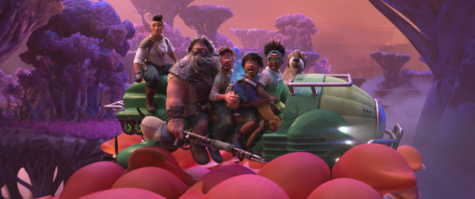
Most of the buzz around the film has been generated by the character of Searcher’s son Ethan, voiced by Jaboukie Young-White. Ethan, who is in high school, is explicitly stated to have romantic feelings for Diazo, another boy his age. This simple fact has generated a large controversy around the film, with the film’s Google rating at 1.5 stars due to hundreds of outraged audience reviews. The content of the film is about as inoffensive as it gets, a teen crush between two boys who enjoy playing card games together, but for all the fury this storyline has caused, its significance in the film is underwhelming. It is certainly the strongest example of LGBTQ representation in a Disney film. However, the subplot itself feels out of place. Although the adults in the film mention Diazo from time to time, he hardly ever appears on screen. He does not even come on the adventure into the titular strange world, so his role is relegated to that of an awkward offscreen presence that feels more shoehorned in than anything. It is representation, but it is not yet representation that is given the same weight or screen time as heterosexual relationships.
“Strange World” is not a bad film. It is wholesome, colorful, and not going to leave a bad taste in any viewer’s mouth. However, when compared to films like “Big Hero 6” which captivated audiences with nuanced characters and exciting battle scenes, “Strange World” stands out as a below-average entry into Disney’s filmography. Its opening weekend earned just 12 million of the film’s 180 million budget at the box office, and profit fell by 60% for its second weekend in theaters. Some of this can be attributed to the controversy surrounding the inclusion of a gay character, but that only accounts for part of the story. “Strange World” comes across like they accidentally made a film out of the rough draft of the screenplay, and when competing with nuanced animated features such as Pixar’s “Turning Red,” stunning animation is not enough to redeem a lackluster storyline and a one-dimensional cast of characters. The most likely scenario is that “Strange World” will come and go without the general public taking much notice. It is unfortunate, though, that a film with such a diverse cast of characters and such groundbreaking representation was not given the script and development that could have brought it success.
“Avatar: The Way of Water” is the second movie in the five-part series by James Cameron. It expands on the fantastical world of Pandora.
‘Avatar: The Way of Water’ is strikingly shallow
“Avatar: The Way of Water” is an enchanting flurry of glowing seas, soaring skies, and amber eyes. Thirteen years after the original “Avatar” made waves across the world, director James Cameron invites viewers to explore the depths of Pandora, the fictional planet around which the films are centered. The spellbinding visuals, dreamlike score, and intense portrayal of emotion during the three-hour-long epic transcends the expectations set by its predecessor. However, its plot is sluggish at times and drags seemingly important characters into the shadows, leaving me questioning its direction.
As new creatures spring to life in every scene, old grievances resurface between the Na’vi, the blue-skinned indigenous people of Pandora, and the humans determined to exploit the planet for its invaluable natural resources, no matter what it costs the Na’vi—a premise identical to that of the first film, but with a few tweakings here and there. They fight over the seas of Pandora, not the forests, and Jake Sully (Sam Worthington) and Neytiri (Zoe Saldaña), the leads of the previous “Avatar,” are sixteen years older than when they were last seen on screen. They have four children to show for it, and a new seaside home where they settle after fleeing the RDA, the human militants.
Jake has clearly shedded his characteristic daringness from the first film, the one that allowed him to lead one of the most climactic battles in Pandora’s history. He now takes on the badge of a family man, which showcases a sterner, more mature side of his character, but diminishes his ability to strike back at the militants. This was no doubt emphasized by the fact that they always have his kids hostage. Neytiri is still the same fierce and loving character from the original, since unlike Jake, family has always been a great force for her.
Despite disappointments and surprises with its plot, “The Way of Water” goes all-out in terms of visual detail. The seas of Pandora surge just like those of our world. The characters’ faces, down to their skin’s texture and the curl of their eyelashes, are crafted meticulously. They convey emotion across the barrier of animation, as they smile and cry and soften their eyes in the same way that we do. Lilting voices and crashing percussion contrast each other in the film’s soundtrack, which only heightened its emotional impact.
It’s clear that “The Way of Water” is setting up for new protagonists to take over in the next film, with Jake and Neytiri’s kids displaying immense bravery and connections to Eywa, the life force and goddess of Pandora, when their parents could not. The next installment in the “Avatar” series will undoubtedly be just as enthralling as “The Way of Water,” which was a truly magical experience, even if only for its visual aesthetic and captivating world.
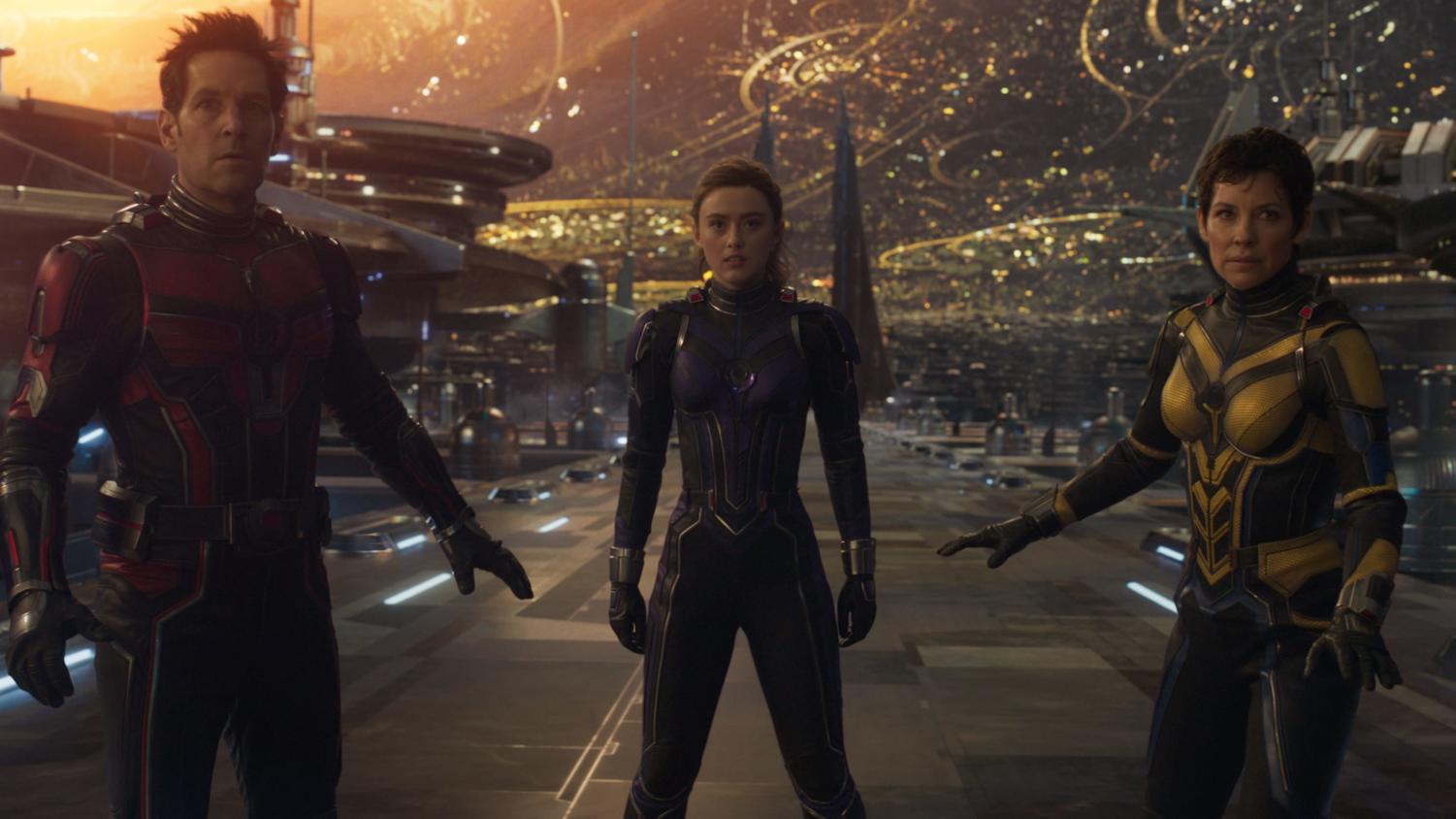
“Ant-Man and the Wasp: Quantumania” kicks off Phase 5 of the Marvel Cinematic Universe and introduces a new major villain, Kang.
‘Ant-Man and the Wasp: Quantumania’ attempts dimension but falls flat
Ant-Man: A name that does a disservice in describing the sheer enormity of this character, from physical size to iconic personality. Every Marvel movie thus far has served to deepen the collective love of Paul Rudd’s hero, mainly through his comedic antics, and while Ant-Man’s performance was never a lackluster element of “Ant-Man and the Wasp: Quantumania,” other parts of it—alluded to by its 47% on Rotten Tomatoes—surely were.
The film opens up with one of the most creative intros of any Marvel movie thus far: Scott Lang (Rudd), the titular character, strutting downtown and regaling the situation of his life as a middle-aged man (and former hero) directly to the audience. We later realize that this is all part of the closing paragraphs of his self-published memoir, a central point of comedic value to the characters. This set the tone for the rest of the film—as the viewer has come to expect with any installment of “Ant-Man”—as one filled with trashy fun; at this point, I was extremely excited.
Another aspect set up by the introduction was Lang’s relationship with his daughter, Cassie. For those behind on the Marvel timeline, Ant-Man had been M.I.A. for five years in the Quantum Realm, not having any opportunity to watch his child grow. Five years later, a lot has changed, and this dynamic of slight unfamiliarity is covered and iterated upon as the two acclimate and their relationship deepens.
Disappointingly, the movie experiences an aforementioned decline in quality. Janet (Hayley Lovitt), the Wasp’s mother, seems to spring out of nowhere as a character with immense amounts of knowledge. “I’m a pretty big Marvel fan myself, and I had no idea who she was before this movie,” sophomore Aaron Logsdon said. She had been stuck in the deep Quantum Realm for a very extended period of time (a plot crutch, of sorts) and before you know it, she’s right back where she started—along with the rest of the cast. This “scientific mishap” is an inciting incident all too relied upon in the Marvel Cinematic Universe, prompted in this film by Cassie. “Of course the kid had to do it,” sophomore Saif Salchak said.
It is then that we are introduced to the monstrous antagonist, Kang the Conqueror (Jonathan Majors): one of the two saving graces of this film along with the Ant-Man himself. It is revealed that he had a friendship with Janet in the Quantum Realm, introducing himself as a stranded and benevolent man with access to unprecedented levels of (broken) technology. This visage is, quite clearly, a part of his true character. His other half is sinister, cold, and calculating, unleashing bouts of unadulterated rage whilst murdering entire populations in his conquest, then strategically torturing Cassie in front of Lang in order to cement his cooperation.
Since his time as a castaway with Janet, he has built up an empire and taken full control of the quantum realm, hoping to mobilize this empire around the multiverse once his technology has been successfully repaired. Naturally, for our protagonists to leave, they must interact with this ruler of the domain. Kang’s character is deep and powerful—being an emotional, stereoscopic figure in an alien world. He possesses uncontrollable motivations, masked by a veil of genuineness, and Majors brings about his villain’s reality with flawless execution.
Despite Kang’s presence, the positives stop there with the amount of unnecessary theatrics this production contained. A giant floating head named MODOK, who turned out to be some long-lost villain from the original “Ant-Man,” seemed to be a horrendous attempt at recreating Paul Rudd’s personality—especially considering this character was very different in his appearance in the previous film. This was combined combined with a large plothole: “If Ant-Man was stuck in the quantum realm for five years, how had he never discovered any of this in the first place?” Salchak asked.
“Ant-Man and the Wasp: Quantumania” seems to necessitate low quality in its aims to live up to the prior feature films, and is sorely beaten by Marvel’s last film, “Black Panther: Wakanda Forever.” With Ant-Man, the protagonist, and Kang, the antagonist, serving to provide a quality dipole in terms of depth and role, the rest of the story revolves around these three-dimensional characters as a two-dimensional plane. Rating: 4/10.

‘Cocaine Bear’ was released on Feb. 26, 2023. Despite being inspired by a true story, the film lacks creativity and can only rely on its outlandish premise to appeal to the audience.
‘Cocaine Bear’ is just pointless
In “Cocaine Bear,” a bear gets high on cocaine and goes on a violent rampage. If you are expecting anything else from the film’s one-and-a-half hour runtime, you should drastically lower your expectations. The film’s listed genre of ‘Comedy Horror’ is not the most apt descriptor. It is not particularly funny or scary, rather plods on at an aggravating pace punctuated by moments that are clearly intended to be jokes but do not quite land. Director Elizabeth Banks has made a genuine effort to create something compelling out of a weird 80s news story, but the resulting film exists for the purpose of its name and premise rather than for any merit it might (not) offer.
Along with the titular bear, there are a variety of human characters who appear in the film. Two kids skipping school, a worried mother searching for them, a gang of no-good teens wreaking havoc, and a grumpy park ranger are just some of the many colorful characters roaming through the park. The most interesting out of the many subplots features Ray Liotta of “Goodfellas” and O’Shea Jackson Jr. of “Straight Outta Compton” as the intended recipients of the cocaine shipment, but even their determined quest to recover the lost goods before their clients get angry quickly grows old as the audience is constantly reminded that there is only so much to say here. There is a bear high on cocaine. That’s about it.
Another issue posed by the presence of park rangers and drug lords in the film is that these characters are inevitably carrying weapons. When police also enter the park in search of the cocaine, there is a shocking amount of characters carrying guns around and a grand total of zero who manage to shoot and kill the bear. Of course, killing the bear would prematurely end the film, so this leaves the writers to think up increasingly frustrating reasons for why they do not shoot the bear. Bear enthusiasts in the audience may argue that shooting a bear is not always enough to stop it from attacking you, but surely it is worth a try? The presence of so many unused guns makes the whole thing feel like a pointless endeavor that should have ended an hour earlier.
“Cocaine Bear” must be commended for delivering on everything the title promises. A bear certainly does cocaine in the film, and that alone is probably enough to draw people to the theaters. Maybe it is unfair to expect comedy or logic from a film that is just trying to show people what happens when a bear does cocaine. In fact, it is probably the best film in existence on the topic. The film currently has a 73 percent audience score on Rotten Tomatoes and is far outperforming expectations at the box office. Fortunately, there has only been one recorded instance of a bear getting high on cocaine, so if they decide to make a sequel they will need to be a little more creative next time.
